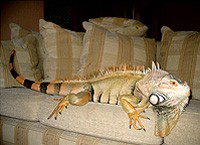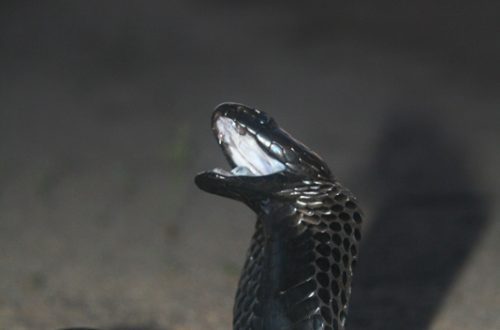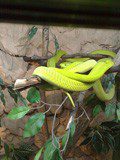
Mamba narrow-headed
The eastern mamba is the smallest member of the mamba genus. The average length of an adult is about 180 cm, although individuals up to 250 cm long have been recorded. This is a very beautiful representative of the mamba genus. In adult snakes, the scales shimmer in emerald green, but sometimes yellow or blue scales are found. The belly is green, light green or yellow. Juveniles are yellowish or greenish until they reach 70-80 cm in length, after which the color changes to emerald green. The body of this mamba is elongated and strong, the head is different from the neck.
Contents
Classification
Kingdom: Animals
Type: Chord
Subtype: Vertebrates
Class: Reptiles
Order: Scaly
Suborder: Snakes
Family: Asps
Genus: Mambas
Species: Narrow-headed or eastern mamba – Dendroaspis angusticeps
Inhabitation
 The habitat of the narrow-headed mamba is the west of South Africa, Mozambique, Eastern Zambia, Natal, Tanzania. They are mainly located in evergreen forests, but often they can be found on tea or mango plantations.
The habitat of the narrow-headed mamba is the west of South Africa, Mozambique, Eastern Zambia, Natal, Tanzania. They are mainly located in evergreen forests, but often they can be found on tea or mango plantations.
This species is distributed in the territories of Natal, Eastern Zambia, South Africa, Tanzania and Mozambique. They mostly live in evergreen forests, but are often found on mango or tea plantations. The eastern mamba feeds mainly on the food that is on the trees, although sometimes during the hunt it also descends to the ground. Its main diet consists of frogs, arboreal mammals and birds.
When caught, the narrow-headed mamba behaves quite calmly, unlike other representatives of this genus. Because of their calm nature, these snakes are very attractive to terrarium keepers. To keep this mamba, you will need a spacious terrarium, in which case you will be able to constantly observe their good and active behavior. They can also be kept in a group, just be prepared for the fact that during the breeding season, males will arrange fights for the right to possess a female.
Despite the fact that the narrow-headed mamba is quite calm and cases of attacks on humans are extremely rare, since the snake most often tries to evade persecution, its venom is extremely neurotoxic, it affects the nervous tissue, and therefore potentially fatal.
The peak activity of the eastern mamba falls on the daytime, although it is rarely seen on the ground – only when it is basking in the sun or after chasing prey.
Description
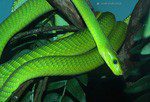 The narrow-headed mamba is the smallest of all members of the mamba genus. On average, the size of an adult narrow-headed mamba is about 1 m, but specimens reaching 8 m are also known. Males are usually larger than females. Adults of this species have an emerald green color, although sometimes yellow or blue scales may be present. The belly is light green, yellow or green. Young representatives of the species are colored greenish or yellowish until they reach a length of 2-5 cm, after which they change color to emerald green.
The narrow-headed mamba is the smallest of all members of the mamba genus. On average, the size of an adult narrow-headed mamba is about 1 m, but specimens reaching 8 m are also known. Males are usually larger than females. Adults of this species have an emerald green color, although sometimes yellow or blue scales may be present. The belly is light green, yellow or green. Young representatives of the species are colored greenish or yellowish until they reach a length of 2-5 cm, after which they change color to emerald green.
The body of the eastern mamba is strong and elongated, the head is different from the neck. The eyes have a large round pupil, the iris is green. In the eastern mamba, the eyes are always open due to the fact that they are protected by transparent shields, and not by eyelids. The scales around the mouth are yellowish. There are 17 to 21 scales around the body. The ventral scutes of the eastern mamba are from 201 to 223 pieces, the caudal scutes from 99 to 126, the lower labials from 9 to 11, the upper labials from 7 to 9, the postorbital scutes from 3 to 5, and the preorbital 3 pieces. The anal shield of this mamba is divided.
Unlike the black mamba, the eastern mamba is very calm, and in case of danger will try to hide in the foliage. When caught, he behaves quite calmly. Cases of attacks by the eastern mamba on a person are extremely rare; when meeting with him, the snake always tries to hide. However, the eastern mamba’s venom is potentially lethal – it has a strong neurotoxic effect, affecting nervous tissue. The wound after a snake bite is represented by two punctures. As for the swelling around the bite, it is either absent altogether or insignificant. The narrow-headed mamba is born already poisonous.
Food
The eastern mamba feeds mainly on birds, frogs and small arboreal mammals. They hunt most often in trees, but they can also descend to the ground in search of prey. This mamba reacts to the movement of its prey, so just one careless stroke will be enough to strike. From the bite of this snake, the victim will feel burning pain. As it spreads through the body, the poison will eat away at the tissue, leaving scars and causing necrosis of the limbs.
In captivity, you can feed them rats, mice, chickens or hamsters. Adults can be fed once a week, young ones can be fed twice a week. It is best to alternate food.
Reproduction
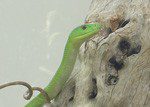 The eastern mamba is oviparous, like all snakes of the mamba genus. The mating process in the eastern mamba always takes place on the branches of trees and takes a decent amount of time – 15-17 hours. During the mating season, males compete with each other for the attention of the female. It is similar to a mating dance, during which one male tries to pin the other to the ground. Such dances can go on for several hours. Pregnancy of the female lasts 3-4 months, then the snake lays 6-18 eggs. Incubation of eggs at a temperature of 28-30 degrees and a humidity of 40-50% lasts 58-88 days. It is best to incubate the eggs in a dry incubator (a cuvette with a filler such as sphagnum is suitable for this). Snakes are born about 40 cm long and their first molt occurs after 9-11 days. When bred in terrariums, newborn mambas may appear olive green or yellowish in color due to a lack of ultraviolet light.
The eastern mamba is oviparous, like all snakes of the mamba genus. The mating process in the eastern mamba always takes place on the branches of trees and takes a decent amount of time – 15-17 hours. During the mating season, males compete with each other for the attention of the female. It is similar to a mating dance, during which one male tries to pin the other to the ground. Such dances can go on for several hours. Pregnancy of the female lasts 3-4 months, then the snake lays 6-18 eggs. Incubation of eggs at a temperature of 28-30 degrees and a humidity of 40-50% lasts 58-88 days. It is best to incubate the eggs in a dry incubator (a cuvette with a filler such as sphagnum is suitable for this). Snakes are born about 40 cm long and their first molt occurs after 9-11 days. When bred in terrariums, newborn mambas may appear olive green or yellowish in color due to a lack of ultraviolet light.
Content
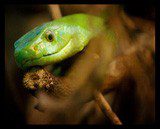 Unlike the Black Mamba, the Eastern Mamba is a rather calm snake that will try to hide in the foliage when danger arises. When caught, she behaves quite calmly.
Unlike the Black Mamba, the Eastern Mamba is a rather calm snake that will try to hide in the foliage when danger arises. When caught, she behaves quite calmly.
The bright emerald color and rather calm nature made the eastern mamba very attractive for terrarium keepers. Catching a representative of this species is quite simple, you can use the hook and tail method. However, when touching its tail, be aware that the snake may become nervous. Although cases of eastern mamba attacks on humans are very rare, the snake always tries to hide.
You need to keep the eastern mamba in a spacious cubic type terrarium – in this case you will constantly see their good and active behavior. These mambas are always interested in everything new – whether it’s a novelty in the interior of their terrarium or movement behind the glass. They get along great together in large groups. For example, a group of six snakes (four females and two males) would require a terrarium measuring 220 cm long, 180 cm high and 10 cm deep. Inside the terrarium, it is necessary to place a variety of snags and branches, live or artificial plants. As a substrate, you can use a mixture of moss, bark and peat, or moss with coconut substrate and bark. You will need a pool of about 20 liters. It can be made retractable, which will facilitate the replacement of water. The temperature under the lamp should be up to 35 degrees, background 28-30 degrees. At night, the temperature will need to be lowered by 3-5 degrees. It is necessary to maintain good lighting + UV lamps. Humidity is maintained at 70%. Warming up is best done with an incandescent lamp, which will need to be placed on top of the terrarium (about 150 W), as well as with the help of two more 60 W lamps, located about 100 cm from the bottom of the terrarium. While equipping the terrarium, do not forget about the fluorescent lamp.
Processing the eastern mamba is quite simple, you can use the tail method and a hook for this. However, when you touch its tail, be prepared for the fact that the snake may become a little nervous.
At home, the narrow-headed mamba should be fed with hamsters, rats, chickens and mice. Young snakes will need to be fed twice a week, while adults will need to feed once a week. The diet is best to alternate.
The eastern mamba, like all members of the mamba genus, is oviparous. On average, there are 6 to 18 eggs in a clutch. After a period of 97-104 days, the female lays eggs. For incubation, a dry incubator, such as a cuvette with moss, is suitable. The incubation period lasts 85-88 days at a temperature of 28 to 30 degrees and a humidity of about 40-50 percent. Babies are born about 40 cm in length, their first molt occurs on the 9-11th day. While still newborn, these snakes are already poisonous. When bitten, the mouse dies within seconds, and the full volume of poison in the glands of the eastern mamba will be enough to kill nine people.
Additionally
The narrow-headed mamba is included in the Top 20 most venomous snakes on the planet, it has a very strong poison, which is more toxic than that of some cobras. A mouse bitten by a narrow-headed mamba dies in just a few seconds. And the full volume of poison that is contained in the glands of one mamba will be enough to kill nine people. If we compare the eastern mamba with the black one, then the first one is considered more dangerous for a person, despite the fact that the black mamba is a fast samba, and it has a stronger poison. This is because the eastern mamba often settles on mango and tea plantations, so during the harvest, a person can unwittingly disturb the snake.
This type of mamba is the smallest snake of the mamba genus.
The eastern mamba is often confused with the boomslang, Dispholidus typus.
Sources of
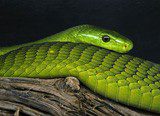 http://zmeya.siteedit.ru
http://zmeya.siteedit.ru
http://petland.org.ua
http://www.spa-kraj.org
http://crazy-zoologist.livejournal.com
http://zmeya.siteedit.ru
Other names
Dendroaspis angusticeps, the eastern green mamba.



